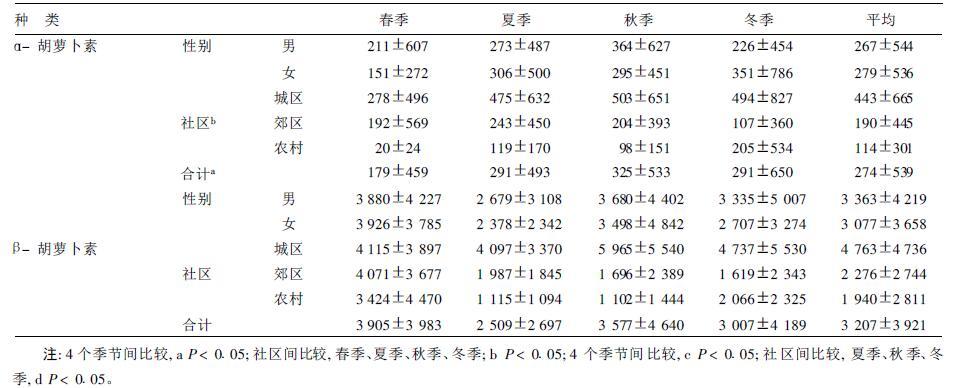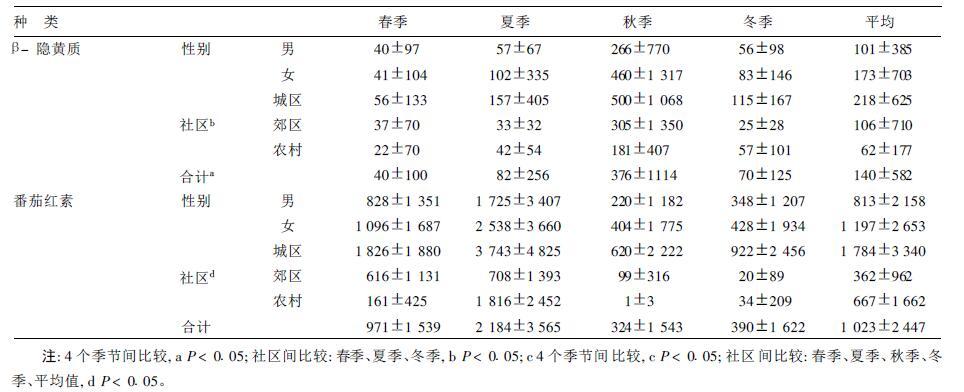引用本文

宋新娜, 汪之顼. 成人膳食中类胡萝卜素摄入量分析[J]. 中国公共卫生, 2007, 23(11): 1378-1380.

SONG Xin-na, WANG Zhi-xu Investigation on dietary carotenoid intake of adults[J]. Chinese Journal of Public Health, 2007, 23(11): 1378-1380.

成人膳食中类胡萝卜素摄入量分析
宋新娜
1,2, 汪之顼
1
1. 青岛大学医学院医学营养学研究所, 青岛, 266021;
2. 山东烟台毓璜顶医院营养科, 264000
收稿日期: 2007-05-06
基金项目: 中国营养学会营养科研基金(2004)
作者简介: 宋新娜(1970- ),女,山东烟台人,主管医师,硕士,研究方向:临床营养。。
通讯作者: 汪之顼
摘要:
目的
了解成年人膳食类胡萝卜素的摄入状况。
方法
采用称重记录法,按季节调查城区、郊区、农村3类不同社区184名30~60岁居民连续3 d的膳食情况,参照1993年美国农业部-国家癌症研究院(USDA-NCI)食物类胡萝卜素数据库、1998年美国农业部-营养协调中心(USDA-NCC)食物类胡萝卜素成分数据库和最新版美国食物成分数据库(SR18)建立的α-胡萝卜素、β-胡萝卜素、β-隐黄质、番茄红素、叶黄素/玉米黄质5种类胡萝卜素的食物成分表,计算类胡萝卜素每日摄入量。
结果
α-胡萝卜素年平均摄入量为(274±539)μg,春、夏、秋、冬四季分别为(179±459),(291±493),(325±533),(29l±650)μg。β-胡萝卜素的年平均摄入量为(3 207±3 921)μg,四季分别为(3 905±3 983),(2 509±2 697),(3 577±4 640),(3 007±4 189)μg。β-隐黄质年平均摄入量为(140±582)μg,四季分别为(40±100),(82±256),(376±1 114),(70±125)μg。番茄红素摄入量为(1 023±2 447)μg,四季分别为(971±1 539),(2 184±3 565),(324±1 543),(390±1 622)μg。叶黄素/玉米黄质年平均摄入量为(2 937±4 512)μg,四季分别为(5 053±6 908),(1 930±2 228),(2 556±3 746),(2 510±3 703)μg。α-胡萝卜素、β-隐黄质秋季摄入量最高,β-胡萝卜素、叶黄素/玉米黄质春季最高,番茄红素夏季最高。不同性别居民类胡萝卜素摄入量比较差异无统计学意义(P>0.05)。城市居民的摄入量高于郊区和农村居民。
结论
利用美国类胡萝卜素成分数据,估计了成人膳食类胡萝卜素摄入量。
关键词:
胡萝卜素
膳食
成年人
营养成分计算
摄入量
Investigation on dietary carotenoid intake of adults
SONG Xin-na, WANG Zhi-xu

1. 山东烟台毓璜顶医院营养科, 264000;
2. Institute of Medical Nutrition, Qingdao University Medical College, Qingdao 266021, China
Abstract:
Objective
To estimate dietary intake of carotenoids among some adults from different communities of China.
Method
One hundred and eighty four 30~60 years old adults(84 males and 100 females)from a urban community,a suburban community and a rural community were recruited into a dietinvestigation,in which the diets of continuous 3 days were recorded in summer,autumn,winter and spring within a year.The dietary records were used to calculate intakes of carotenoids (β-carotene,α-carotene,β-cryptoxanthin,lycopene,and lutein/zeax anthin),based on three USA carotenoids databases,the 1993 United States Depar tment of Agriculture-National Cancer Institute(USDA-NCI)Carotenoid Database,the 1998 United States Depar tment of Agriculture-Nutrition Coor dinating Center(USDA-NCC)Carotenoid Database for US Food,and the USDA national nutrient database for standard reference(SR18).
Result
The calculated average daily intake of A-carotene of all subjects in a year was(274±539)μg,with seasonal values were(179±459)μg inspring,(291±493)/μg in summer,(325±533)μg in autumn,and(291±650)Lg in winter,respectively.The calculated average daily intake of B-carotene were(3 207±3 921)μg in a year,and seasonal values were(3 905±3 983),(2509±2697),(3 577±4 640),and(3 007±4 189)μg respectively.That of β-cryptoxanthin were(140±582)/μg,as well as(40±100),(82±256),(376±1 114),(70±125)μg respectively.And that of lycopene were(1 023±2 447),(971±1 539),(2 184±3 565),(324±1 543), (390±1 622)μg,respectively.The average lutein/zeaxanthin intake was(2937+4512)μg per day,and seasonal levels were (5 053±6 908),(1 930±2 228),(2 556±3 746),and(2 510±3 703)μg respectively.The highest β-caro tene and lutein/zeax anthin intake occurred in spring,and the highest α-carotene and β-cryptox anthin intake occurred in autumn,the high-estly copene intake in summer.There was no significant difference between males and females(P>0.05).The subjects from the urban co mmunity consumed more carotenoids than those from the suburb and the rural communities.The 40~49 years group had highest intake of caro tenoids except β-carotene and lutein/zeax anthin,while 30~39 years group had lowest except α-carotene.
Conclusion
The dietary intakes of caro tenoids of 184 Chinese adult residents at seasons around a year are estimated by computing metho d based on the dietary records and the USA carotenoids databases.
Key words:
carotenoids
dietary survey
adult
nutrient calculation
intake
类胡萝卜素是一组存在于植物和微生物中的生物活性物质,动物自身不能合成。人体组织内的类胡萝卜素来源于膳食,尤其是蔬菜水果的摄入[1]。体内含量较高的类胡萝卜素主要有β-胡萝卜素、α-胡萝卜素、番茄红素、叶黄素(或称玉米黄素)、玉米黄质、β-隐黄质等[2]。本文采用膳食调查方法,参照美国的食物成分数据库,计算部分中国成人5种主要类胡萝卜素的膳食摄入量。
1 对象与方法
1.1 对象 按照类型抽样方法,分别选择山东省济宁市城区中心位置的北门社区(城区)、城市周边的国光社区(郊区)和远郊农村任城区的安居镇某自然村(农村)为调查地点。采用知情同意的原则,从3个社区随机选择184名30~60岁居民为调查对象,年龄(44.1±8.1)岁,其中男性84人,女性100人。城区62人(男性31人、女性31人),郊区57人(男性28人、女性29人),农村65人(男性25人、女性40人)。3个调查点居民的性别构成差异无统计学意义(P>0.05)。
1.2 方法
1.2.1 膳食调查方法 采用称重记录法[3]。分别于2005年6~7月、2005年9~10月、2005年12月~2006年1月、2006年3~4月进行。连续调查3d的饮食(其中包括1天周末,但避免节假日或非常规聚餐)。
1.2.2 食物类胡萝卜素成分数据 依据1993年美国农业部-国家癌症研究院(USDA-NCI)食物类胡萝卜素数据库、1998年美国农业部-营养协调中心(USDA-NCC)食物类胡萝卜素成分数据库和最新的美国食物成分表(第18版),对本调查中涉及食物的类胡萝卜素成分数据进行归纳、整理,形成类胡萝卜素成分表,数据涵盖β-胡萝卜素、α-胡萝卜素、β-隐黄质、番茄红素、叶黄素/玉米黄质的含量[4]。少量中国特有食物在美国的上述数据库中查不到相关数据,则根据食物的种类、水分含量以及国内食物成分表中胡萝卜素含量水平查找类似食物的类胡萝卜素值进行估计。
1.2.3 膳食类胡萝卜素含量的计算 利用上述食物类胡萝卜素成分数据和调查食物消费量,计算膳食样品中β-胡萝卜素、α-胡萝卜素、β-隐黄质、番茄红素、叶黄素/玉米黄质的含量和每日膳食摄入量。
1.3 统计分析 采用SPSS 11.5软件进行单因素方差分析(ANOVA),比较每日膳食中类胡萝卜素摄入量在不同季节、不同社区间的差别;采用独立样本t检验方法比较不同性别间类胡萝卜素摄入量的差异。
2 结果
2.1 不同性别、季节α-和β-胡萝卜素膳食摄入量(表 1)
表 1

表 1 不同性别、地区和季节成年人α-和β-胡萝卜素膳食摄入量
|
表 1 不同性别、地区和季节成年人α-和β-胡萝卜素膳食摄入量
|
2.2 不同性别、季节β-隐黄质和番茄红素膳食摄入量(表 2)
表 2

表 2 不同性别、地区和季节成年人β-隐黄质和番茄红素膳食摄入量
|
表 2 不同性别、地区和季节成年人β-隐黄质和番茄红素膳食摄入量
|
2.3 不同性别、季节叶黄素/玉米黄质膳食摄入量(表 3)
表 3

表 3 不同性别、地区和季节成年人叶黄素/玉米黄质膳食摄入量
|
表 3 不同性别、地区和季节成年人叶黄素/玉米黄质膳食摄入量
|
3 讨论 此次调查地点为中国北方地区,受膳食类胡萝卜素来源食物供应的影响,5种类胡萝卜素的每日摄入量在不同的季节差异均有统计学意义(P< 0.05)。α-胡萝卜素、β-隐黄质的平均摄入量在秋季最高,主要是因为秋季橙色、红色蔬菜水果相对较多,如胡萝卜、南瓜、橘子、柿子等。夏季西红柿、西瓜供应充足,番茄红素摄入量成倍地高于其他季节。β-胡萝卜素、叶黄素/玉米黄质的食物来源较多,但是四季比较春季摄入量相对较高,与北方地区春季绿色蔬菜如菠菜、野菜等供应丰富有关。男女之间类胡萝卜素摄入量差异均无统计学意义(P< 0.05)。城区居民5种类胡萝卜摄入量均高于郊区及农村居民,与经济水平、食物供应状况、文化程度、营养知识了解关注程度有一定的关系。
 2007, Vol. 23
2007, Vol. 23




